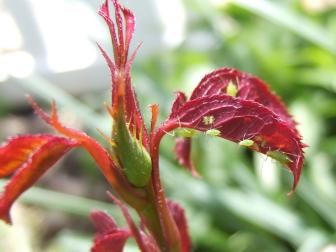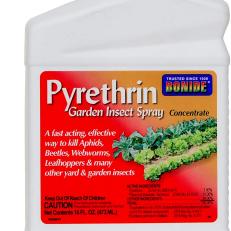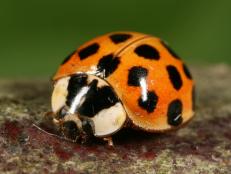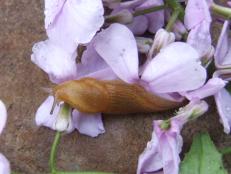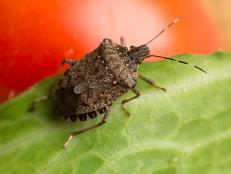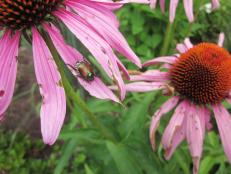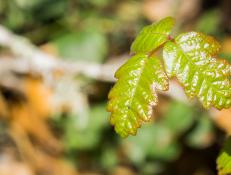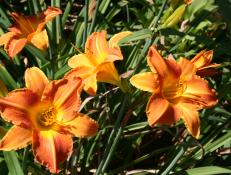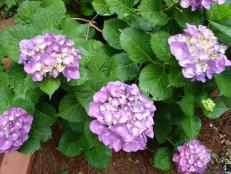How to Get Rid of Thrips
Thrips can damage your plants before you even know they’re there. Here’s how to spot thrips on plants and get rid of them.
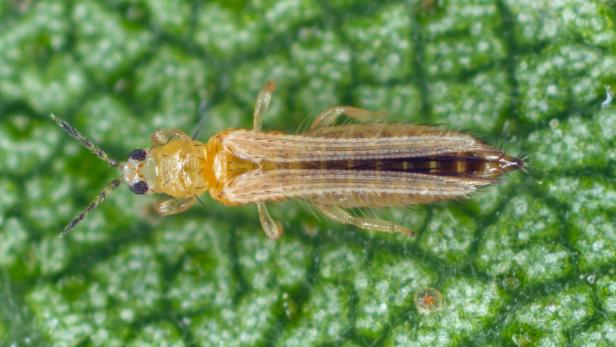
shutterstock/Tomasz Klejdysz

Thrips. Ugh, they’re the worst. Also known as thunderflies, these insects suck the life juices out of your plants. They stunt plant growth and make them ugly by distorting and scarring their leaves, branches and blooms. Sometimes thrips transmit viruses or bacterial diseases to plants, making the damage even worse.
Read on to learn how to get rid of thrips on plants.
Thrips 101
There are more than 5,000 species of thrips, but only 100 to 200 are known to be bad bugs that eat plants we want. The rest are beneficial bugs or do no harm to plants we care about.
The pest variety eat flowers, vegetables, fruit trees, shrubs, woody plants and herbaceous plants. They’re to garden insects what seagulls are to birds: garbage guts who will eat almost anything.
Most thrip species have wings, but they’re poor fliers who move by wind power instead of wing power. Up close they look like a cross between an earwig and a skinny, pale roach. Like most insects, they’re social critters who live in clusters, so they swarm your plants with disastrous results. Thrips are usually translucent white, black or ochre.
How to Identify Thrips
Thrips are tiny — around 1/20 of an inch long and the diameter of a sewing needle — so by the time you spot them, they’ve already done serious damage to your plants. What you will see initially is leaves falling off your ZZ plant, yellow, bleached spots on your cabbage or stunted blooms on your hibiscus. You’ll think your plant has a nutritional problem or a fungus.
To check for thrips on houseplants, put a sheet of white paper under the flowers and leaves and shake the plant. This works on outdoor plants, too. If you’ve got thrips, they’ll fall off the plant and land on the paper where you’ll be able to see them. Use a magnifying glass to help identify the little monsters.
Sticky traps are another way to identify thrips. Put a trap by your plant and see if thrips show up in it. Note: A sticky trap will not get rid of your thrip problem. It will just confirm you have a thrip problem.
How to Get Rid of Aphids
Find out from the garden experts at HGTV how to identify and get rid of aphids.
Thrips or aphids?
Thrip damage looks a lot like aphid damage. Both of these bugs deform leaves, leave a shiny residue on the plant (it’s bug excrement) and encourage black mold growth. That’s why you need to look at the bugs with a magnifying glass. Aphids will be oval-shaped. Thrips will be long and skinny.
Thrips tend to eat new leaf growth while aphids eat the stem and mature leaves. You may be so unlucky that you have thrips and aphids munching on your plants at the same time. The good news is you can control both bugs with the same solutions.
How to Get Rid of Thrips
Once you’ve confirmed a thrip invasion, you’ve got several options for managing it.
Prune Thrip-Damaged Plants
Remove all thrip-damaged leaves, blooms and stems, and throw them in a trash can. If the plant is badly infested, get it away from the rest of your plants entirely so the thrips won’t spread. Depending on how attached you are to the plant, the best decision you may make as a plant parent is to toss the entire thrip-infested plant into the trash. It’s tough to do, but throwing away the plant is a surefire thrip treatment.
Wash Thrips Off Plants With Water
Get thrips off the leaves of outdoor plants with a blast of water from the hose. Focus on the underside of leaves where they gather. For indoor plants, apply a solution of soap and water on leaves with a spray bottle. Mix 2 teaspoons of dish soap with a gallon of water and saturate all parts of the infested plant. Note: This is a form of thrip control, but it will not prevent them from returning.
Spray Plants With Neem Oil
Neem oil is a natural pesticide made from the neem tree. It’s a must-have for gardeners because, unlike synthetic pesticides, it wipes out bad bugs like thrips or white fly without harming good bugs like bees and other pollinators. Neem oil works by turning off the insect hormones that make them eat and mate.
Here's how to get rid of thrips with neem oil:
- Wash the thrips off your plant.
- Mix 4 teaspoons of neem oil and 2 teaspoons of dishwashing soap into one gallon of water.
- Spray on the infested parts of the plant.
Neem oil doesn’t kill thrips on contact, so you won’t get the satisfaction of seeing the creatures that wrecked your plant wheeze and die. Neem oil provides systemic pest control. Your plant absorbs neem oil into its tissue where its ingredients will disable bugs who try to eat the plant in the future. It's like a vaccine for a plant.
Spray Plants With Pyrethrin
Pyrethrin is a natural pesticide made from chrysanthemums that will get rid of thrips. You’ll need to spray pyrethrin on infested plants twice, allowing 4 days between applications. Care about the environment? Use a pure pyrethrin pesticide, which is safer than a pyrethroid pesticide that has added synthetic chemicals to make it more deadly to insects. Pyrethroids can also kill honey bees and fish if they get into waterways. Read the label to be sure what you’re getting before you spray.
Buy Supplies
Spray With a Synthetic Chemical Pesticide
Lots of synthetic pesticides kill thrips on plants, but this is the least effective and most environmentally damaging way to rid your plants of these pests. Thrips feed and lay eggs inside of curled new leaf growth and buds where pesticides can’t reach them. And since thrips keep coming all season, you’re going to have to apply pesticide constantly to keep them away. This means you may kill beneficial bugs and earthworms along with thrips, and turn your yard into a dead zone. Thrips also develop resistance to chemical pesticides pretty quickly.
How to Prevent Thrips
You can make your life a lot simpler and be kinder to the planet by stopping thrip invasions before they start. Here’s how to prevent thrips on plants.
Clean Up Garden Debris and Weeds
Thrips are more likely to become a problem in areas where there are lots of weeds to serve as host plants. They also thrive in ground debris, too: dead branches, deadheaded flowers and pruned stems. Put pruned and dead plants in the compost pile and keep your yard and garden weeded so thrips won’t have an inviting place to lay eggs, overwinter and raise their babies in the spring.






